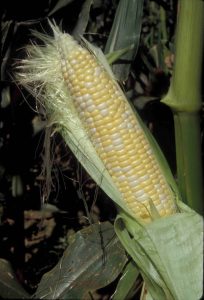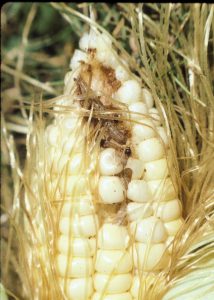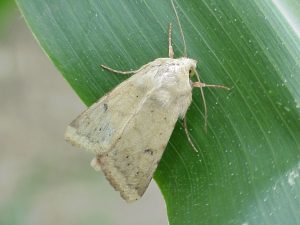Sweet Corn IPM Newsletter No. 9- August 28, 2020

Sweet Corn IPM Newsletter No. 9- August 28, 2020
COOL WEATHER BRINGS PEST NUMBERS DOWN
Fresh Silking Corn Still Under Threat From Earworm, Armyworm
SITUATION
Many sites are still very dry, while others received some showers this week, along with strong winds that caused lodging in some late cornfields. Cool night temperatures and little weather coming up from the south have reduced insect activity, although most remaining fields in silk still require some protection.

European corn borer:
Larval feeding injury was not over the 15% control threshold for pre-silking corn at any location scouted this week. Moth counts were over the weekly threshold of five for silking corn in Wayne, Oxford and Sabattus.

Corn earworm:
Moth captures were down this week; easing spray intervals for silking corn at most sites. A four-day interval for silking corn was only recommended at one Dayton site. A five-day spray interval was recommended in Auburn, New Gloucester, Poland Spring, Wayne and one Cape Elizabeth site. A six-day spray interval was recommended in Bowdoinham, Sabattus, one Cape Elizabeth site, one Dayton site, and one Wells site.

Fall armyworm (FAW):
Moth captures declined at most sites this week, but were high enough in some fields to recommend protection for silking corn not presently under a spray interval for corn earworm. Counts exceeded the three-per-week threshold for silking corn in: Auburn, Biddeford, Cape Elizabeth, Dayton, Monmouth, New Gloucester, Oxford, Poland Spring, and Sabattus. The Biddeford, Monmouth and Oxford sites were not under a spray interval for corn earworm, so a spray for FAW on silking corn was recommended. Fall armyworm larval feeding damage on pre-silking corn exceeded the 15% threshold in Bowdoinham. Many sites do not have any pre-silking corn remaining.
Birds, etc.
Flocking species of blackbirds are starting to cause damage in cornfields around the state. Birds may be more of a problem in dry years, when food and water is more difficult to find. They are especially attracted to fields where corn has been allowed to get over-mature. Deer, skunks and raccoons have also been troublesome this year. For information on wildlife problems and management options, you may call the Animal and Plant Health Inspection Service (APHIS) office in Augusta at 1-866-487-3297.
There’s still time for cover crops!
Plowing down corn stalks and stubble after harvest destroys European corn borer overwintering sites, and is an important part of a good management program. Although, late plowing can leave soil exposed and prone to erosion during the winter and spring. However, planting winter rye after harvest, even well into September, can produce enough of a cover to prevent erosion. Rye grass will survive the winter and put on more growth in the early spring. It should be killed by plowing, mowing or herbicide before it goes to seed. Bear in mind that having rye on the field may delay planting in the spring, as you must wait for conditions to be warm and dry enough to plow it in.
Sincerely,
David T. Handley
Vegetable & Small Fruit Specialist
Highmoor Farm Pest Mgmt. Unit
P.O. Box 179 17 Godfrey Drive
52 U.S. Route 202 Orono, ME 04473
Monmouth, ME 04259 1.800.287.0279
207.933.2100
| Location | CEW
Moths |
ECB
Moths |
FAW
Moths |
%Feeding
Damage |
Recommendations / Comments |
|---|---|---|---|---|---|
| Auburn | 5 | 0 | 14 | 5-day spray interval for all silking corn | |
| Biddeford | 1 | 0 | 7 | 9% | One spray on silking and pre-silking corn for FAW |
| Bowdoinham | 2 | 1 | 0 | 90% | 6-day spray interval for all silking corn |
| Cape Elizabeth I | 2 | 0 | 0 | 6-day spray interval for all silking corn | |
| Cape Elizabeth II | 5 | 0 | 4 | 5-day spray interval for all silking corn | |
| Charleston | 1 | 0 | 1 | No spray recommended | |
| Corinth | 0 | 0 | 0 | No spray recommended | |
| Dayton I | 11 | 1 | 25 | 4-day spray interval for all silking corn | |
| Dayton I | 3 | 1 | 16 | 6-day spray interval for all silking corn | |
| Lewiston | 0 | 3 | 0 | No spray recommended | |
| Levant | 1 | 0 | 0 | No spray recommended | |
| Monmouth | 0 | 0 | 6 | One spray on silking corn for FAW | |
| New Gloucester | 5 | 0 | 4 | 5-day spray interval for all silking corn | |
| Oxford | 0 | 11 | 6 | One spray on silking corn for FAW + ECB | |
| Palmyra | 0 | 0 | 0 | No spray recommended | |
| Poland Spring | 7 | 2 | 9 | 5-day spray interval for all silking corn | |
| Sabattus | 3 | 9 | 26 | 6-day spray interval for all silking corn | |
| Wayne | 5 | 9 | 0 | 5-day spray interval for all silking corn | |
| Wells I | 0 | 2 | 0 | No spray recommended | |
| Wells II | 2 | 0 | 2 | 6-day spray interval for silking corn |
CEW: Corn earworm (Only fresh silking corn should be sprayed for this insect.)
ECB: European corn borer
FAW: Fall armyworm
| Moths caught per week | Moths caught per night | Spray interval |
|---|---|---|
| 0.0 to 1.4 | 0.0 to 0.2 | No spray |
| 1.5 to 3.5 | 0.3 to 0.5 | Spray every 6 days |
| 3.6 to 7.0 | 0.6 to 1.0 | Spray every 5 days |
| 7.1 to 91 | 1.1 to 13.0 | Spray every 4 days |
| More than 91 | More than 13 | Spray every 3 days |
Thresholds apply only to corn with exposed fresh silk. Lengthen spray intervals by one day if the maximum daily temperature is less than 80°F.
European Corn Borer Thresholds
Whorl stage: 30% or more of plants scouted show injury.
Pre-tassel-silk: 15% or more of plants scouted show injury.
Silk: 5 or more moths caught in pheromone traps in one week.
IPM Web Pages:
Where brand names or company names are used, it is for the reader’s information. No endorsement is implied nor is any discrimination intended against other products with similar ingredients. Always consult product labels for rates, application instructions and safety precautions. Users of these products assume all associated risks.
The University of Maine is an equal opportunity/affirmative action institution.
